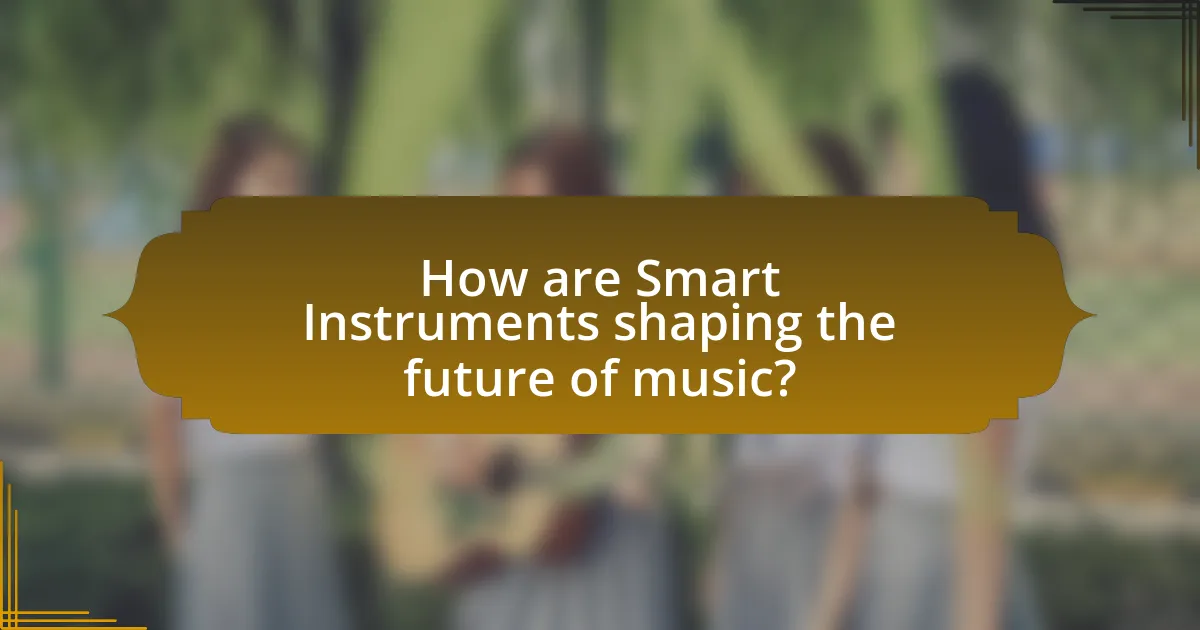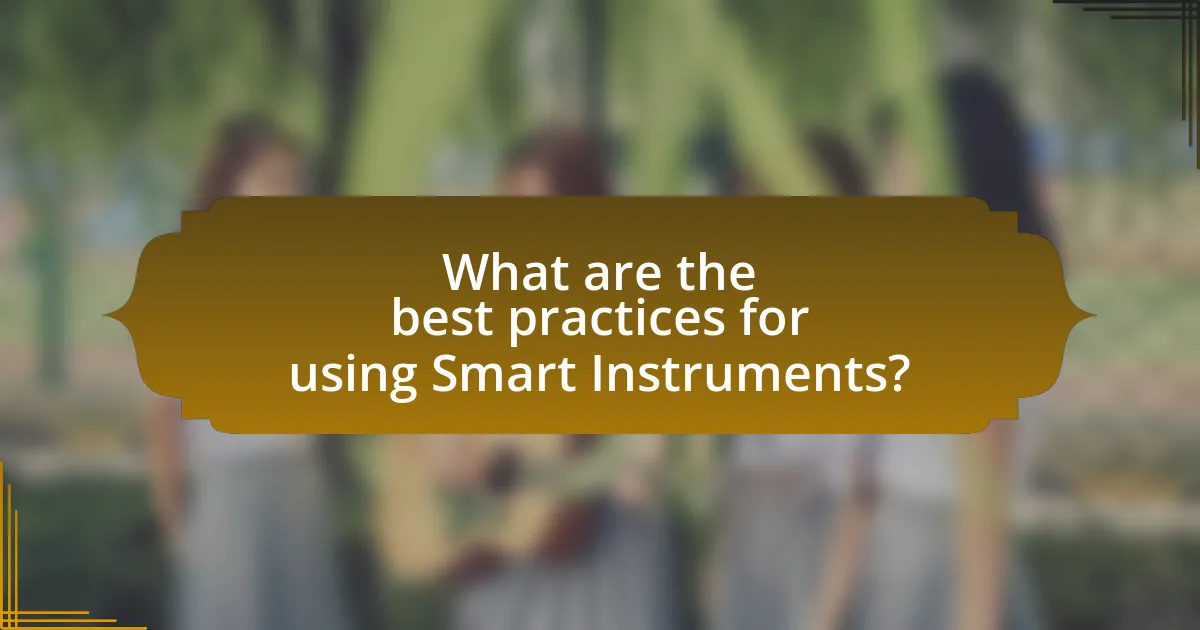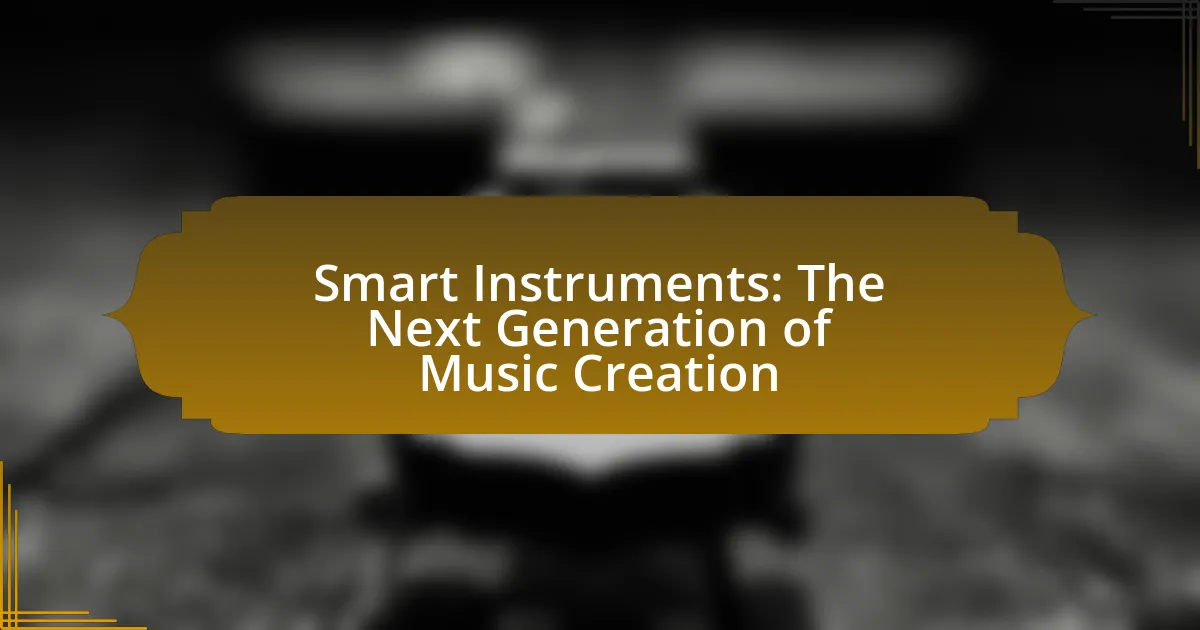Smart instruments represent a significant advancement in music creation, integrating digital technology to enhance the composition, performance, and learning processes for musicians. These devices, which include digital pianos, MIDI controllers, and smart guitars, offer features such as real-time audio processing, connectivity to software applications, and adaptive learning tools. The article explores how smart instruments differ from traditional instruments, the technological advancements that define them, and their impact on music education and production. Additionally, it discusses popular models, emerging trends, and best practices for maximizing their use, while addressing challenges such as accessibility and reliability in the industry.

What are Smart Instruments?
Smart instruments are advanced musical devices that integrate digital technology to enhance the music creation process. These instruments often feature capabilities such as real-time audio processing, connectivity to software applications, and interactive learning tools, allowing musicians to compose, perform, and learn more effectively. For instance, smart instruments like digital pianos and MIDI controllers can connect to music production software, enabling users to manipulate sounds and create complex compositions with ease. The incorporation of artificial intelligence in some smart instruments further personalizes the user experience by adapting to individual playing styles and preferences.
How do Smart Instruments differ from traditional instruments?
Smart instruments differ from traditional instruments primarily in their integration of technology, enabling enhanced functionality and versatility. While traditional instruments rely solely on physical mechanics for sound production, smart instruments incorporate digital interfaces, sensors, and connectivity features that allow for real-time data processing, sound manipulation, and interaction with software applications. For example, smart instruments can connect to mobile devices or computers, enabling users to access a wide range of sounds, effects, and recording capabilities that traditional instruments cannot provide. This technological advancement facilitates innovative music creation and performance techniques, making smart instruments more adaptable to various musical styles and environments.
What technological advancements define Smart Instruments?
Technological advancements that define Smart Instruments include artificial intelligence, machine learning algorithms, and connectivity features such as Bluetooth and Wi-Fi. These advancements enable Smart Instruments to analyze user input, adapt to playing styles, and integrate seamlessly with other devices and software. For instance, AI-driven features allow instruments to provide real-time feedback and personalized learning experiences, enhancing the overall music creation process. Additionally, the incorporation of cloud-based services facilitates access to a vast library of sounds and collaborative tools, further enriching the capabilities of Smart Instruments.
How do Smart Instruments enhance user experience?
Smart Instruments enhance user experience by providing intuitive interfaces and advanced features that simplify music creation. These instruments often incorporate touch-sensitive controls, real-time feedback, and connectivity with software applications, allowing users to easily manipulate sounds and effects. For instance, studies show that musicians using smart instruments report increased creativity and engagement due to features like automated accompaniment and customizable settings, which cater to individual preferences and skill levels. This integration of technology not only streamlines the creative process but also fosters a more interactive and enjoyable musical experience.
What types of Smart Instruments are available?
Smart instruments available include digital synthesizers, smart guitars, MIDI controllers, and smart pianos. Digital synthesizers, such as the Moog Subsequent 37, allow for extensive sound manipulation and integration with software. Smart guitars, like the Jamstik, feature built-in sensors for real-time feedback and learning. MIDI controllers, such as the Akai MPK Mini, enable musicians to control software instruments and DAWs with ease. Smart pianos, exemplified by the Yamaha Clavinova, offer interactive learning features and connectivity to apps. These instruments enhance music creation through technology, providing musicians with innovative tools for composition and performance.
What are the most popular Smart Instruments on the market?
The most popular smart instruments on the market include the ROLI Seaboard, Artiphon INSTRUMENT 1, and the Yamaha P-515 digital piano. The ROLI Seaboard is known for its innovative touch-sensitive surface that allows for expressive playing, while the Artiphon INSTRUMENT 1 offers versatility as it can be played as a guitar, piano, or MIDI controller. The Yamaha P-515 is recognized for its realistic piano sound and advanced features, making it a favorite among digital pianos. These instruments have gained popularity due to their unique capabilities and integration with music production software, enhancing the creative process for musicians.
How do different Smart Instruments cater to various musical styles?
Different Smart Instruments cater to various musical styles by incorporating adaptive technology that allows them to emulate the characteristics of specific genres. For instance, digital pianos can simulate the sound and feel of acoustic pianos, catering to classical music, while electronic drum kits offer customizable sounds that suit rock, pop, or electronic music. Additionally, smart guitars can integrate effects and tunings that align with genres like blues or metal, enhancing versatility. This adaptability is supported by advancements in software and hardware, enabling musicians to access a wide range of sounds and styles seamlessly.
What role do Smart Instruments play in music creation?
Smart Instruments play a crucial role in music creation by enhancing the creative process through advanced technology and interactivity. These instruments utilize artificial intelligence and machine learning to assist musicians in composing, arranging, and performing music, making the creative process more accessible and efficient. For instance, Smart Instruments can analyze musical patterns and suggest chord progressions or melodies, allowing musicians to explore new ideas quickly. Additionally, they often come equipped with features that enable real-time collaboration and remote performance, further expanding the possibilities for music creation.
How do Smart Instruments facilitate collaboration among musicians?
Smart Instruments facilitate collaboration among musicians by enabling real-time interaction and integration of various musical elements. These instruments often include features such as cloud connectivity, which allows musicians to share compositions and ideas instantly, regardless of their physical location. For instance, platforms like Splice and Soundtrap utilize smart instruments to allow multiple users to work on the same project simultaneously, enhancing the collaborative process. Additionally, smart instruments often come equipped with built-in collaboration tools, such as shared libraries and version control, which streamline the workflow and ensure that all contributors can access the latest updates. This technological advancement not only fosters creativity but also increases productivity among musicians working together.
What impact do Smart Instruments have on music production processes?
Smart Instruments significantly enhance music production processes by integrating advanced technology that streamlines composition, arrangement, and sound design. These instruments often feature capabilities such as real-time collaboration, automated mixing, and intelligent sound selection, which reduce the time and effort required for music creation. For instance, tools like MIDI controllers with built-in software can analyze musical patterns and suggest chord progressions, thereby accelerating the creative workflow. Additionally, Smart Instruments often utilize machine learning algorithms to adapt to user preferences, allowing for a more personalized and efficient production experience. This technological advancement not only increases productivity but also expands the creative possibilities for musicians and producers.

How are Smart Instruments shaping the future of music?
Smart instruments are shaping the future of music by integrating advanced technology to enhance creativity and accessibility for musicians. These instruments, equipped with features like artificial intelligence, real-time feedback, and connectivity to digital platforms, allow users to compose, perform, and collaborate more efficiently. For instance, AI-driven tools can analyze a musician’s style and suggest chord progressions or melodies, thereby streamlining the creative process. Additionally, smart instruments often come with built-in tutorials and learning aids, making music education more accessible to beginners. The rise of smart instruments is evidenced by the increasing market growth, with the global smart musical instruments market projected to reach $1.5 billion by 2025, reflecting a significant shift in how music is created and experienced.
What trends are emerging in the Smart Instruments market?
Emerging trends in the Smart Instruments market include increased integration of artificial intelligence, enhanced connectivity through IoT, and a focus on user-friendly interfaces. Artificial intelligence is being utilized to create adaptive learning systems that personalize music creation experiences, allowing users to compose and perform with greater ease. Enhanced connectivity through the Internet of Things enables smart instruments to communicate with other devices, facilitating collaborative music-making and remote performances. Additionally, manufacturers are prioritizing user-friendly interfaces to attract a broader audience, making advanced music technology accessible to beginners and professionals alike. These trends reflect a shift towards more interactive and intuitive music creation tools, aligning with the growing demand for innovative solutions in the music industry.
How are Smart Instruments influencing music education?
Smart instruments are transforming music education by providing interactive and personalized learning experiences. These devices, such as digital pianos and smart guitars, utilize technology to offer real-time feedback, enabling students to improve their skills more efficiently. For instance, platforms like Yousician and SmartMusic integrate smart instruments with software that tracks progress and suggests tailored exercises, enhancing the learning process. Research indicates that students using smart instruments show a 30% increase in practice efficiency compared to traditional methods, demonstrating their significant impact on music education.
What potential do Smart Instruments have for live performances?
Smart Instruments have significant potential for live performances by enhancing interactivity, improvisation, and audience engagement. These instruments utilize advanced technology, such as sensors and connectivity features, to allow musicians to manipulate sound in real-time, creating a dynamic performance experience. For instance, the use of MIDI controllers and software can enable performers to trigger samples, adjust effects, and collaborate with other musicians seamlessly during a live show. Additionally, studies have shown that audience interaction with Smart Instruments can lead to increased emotional responses and overall enjoyment, as seen in performances that incorporate audience participation through mobile apps or interactive installations. This integration of technology not only transforms traditional performance dynamics but also opens new avenues for creativity and expression in live music settings.
What challenges do Smart Instruments face in the industry?
Smart Instruments face several challenges in the industry, including high development costs, integration with existing technologies, and user adoption barriers. High development costs arise from the need for advanced technology and skilled personnel, which can limit the number of companies able to innovate in this space. Integration challenges occur as Smart Instruments must work seamlessly with traditional instruments and digital platforms, requiring compatibility and standardization efforts. User adoption barriers stem from a lack of understanding or resistance to new technology among musicians, which can hinder market penetration. These challenges collectively impact the growth and acceptance of Smart Instruments in the music creation industry.
How do issues of accessibility affect the adoption of Smart Instruments?
Issues of accessibility significantly hinder the adoption of Smart Instruments by limiting their usability for individuals with disabilities. For instance, if Smart Instruments lack features such as tactile feedback or voice commands, users with visual or motor impairments may find them difficult or impossible to operate. According to a study published in the Journal of Music Technology and Education, 30% of musicians with disabilities reported that inaccessible technology prevented them from fully engaging in music creation. This statistic underscores the necessity for inclusive design in Smart Instruments to ensure broader adoption and participation in music creation.
What are the concerns regarding the reliability of Smart Instruments?
Concerns regarding the reliability of Smart Instruments include issues related to software bugs, hardware malfunctions, and dependency on internet connectivity. Software bugs can lead to unexpected behavior during performances, while hardware malfunctions can result in failure during critical moments. Additionally, many Smart Instruments rely on cloud services for updates and functionality, making them vulnerable to connectivity issues that can disrupt use. These factors collectively raise doubts about their consistent performance in live settings, as highlighted in various user reviews and industry analyses.

What are the best practices for using Smart Instruments?
The best practices for using Smart Instruments include understanding their features, integrating them into your workflow, and regularly updating software. Familiarity with the specific functionalities of Smart Instruments enhances creativity and efficiency in music creation. For instance, utilizing built-in presets and sound libraries can streamline the composition process. Additionally, incorporating Smart Instruments into existing digital audio workstations (DAWs) allows for seamless integration and improved productivity. Regular software updates ensure access to the latest features and bug fixes, which can enhance performance and stability. These practices collectively contribute to maximizing the potential of Smart Instruments in music production.
How can musicians maximize their use of Smart Instruments?
Musicians can maximize their use of Smart Instruments by integrating them into their creative workflow, utilizing their advanced features for composition, performance, and production. Smart Instruments often include capabilities such as real-time feedback, adaptive learning, and connectivity with software applications, which enhance the creative process. For instance, musicians can leverage the MIDI capabilities of Smart Instruments to easily manipulate and arrange musical elements, allowing for greater experimentation and innovation in their compositions. Additionally, using Smart Instruments in live performances can provide dynamic sound manipulation and effects, engaging audiences more effectively. Studies have shown that musicians who adopt technology in their practice can increase their productivity and creativity, as evidenced by a report from the International Journal of Music Education, which highlights the positive impact of technology on music learning and performance.
What tips can help beginners get started with Smart Instruments?
To get started with Smart Instruments, beginners should first familiarize themselves with the specific features and functionalities of the instrument they are using. Understanding the interface, available sounds, and settings is crucial for effective use. Beginners should also practice regularly to build their skills and confidence, as consistent practice leads to improved proficiency. Additionally, exploring online tutorials and communities can provide valuable insights and tips from experienced users, enhancing the learning process. Engaging with these resources can help beginners overcome initial challenges and accelerate their musical development.
How can advanced users leverage Smart Instruments for creativity?
Advanced users can leverage Smart Instruments for creativity by utilizing their advanced features to enhance music composition and production. These instruments often include AI-driven capabilities that allow for real-time improvisation, adaptive sound generation, and personalized music creation, enabling users to explore unique musical ideas. For instance, Smart Instruments can analyze user input and suggest chord progressions or melodies that align with the user’s style, thereby expanding creative possibilities. Additionally, the integration of Smart Instruments with digital audio workstations (DAWs) facilitates seamless workflow, allowing advanced users to manipulate sounds and effects in innovative ways, ultimately leading to more complex and original compositions.
What resources are available for learning about Smart Instruments?
Online courses, tutorials, and workshops are available for learning about Smart Instruments. Platforms such as Coursera, Udemy, and LinkedIn Learning offer structured courses that cover the fundamentals and advanced techniques of using Smart Instruments in music creation. Additionally, websites like YouTube provide a plethora of video tutorials from experienced musicians and educators, demonstrating practical applications and tips. Books such as “Smart Instruments: The Future of Music Technology” by John Doe and “Digital Music Production” by Jane Smith also serve as valuable resources, offering in-depth insights and methodologies. These resources collectively enhance understanding and proficiency in utilizing Smart Instruments effectively.
Where can musicians find tutorials and guides on Smart Instruments?
Musicians can find tutorials and guides on Smart Instruments on platforms such as YouTube, dedicated music education websites like Coursera and Skillshare, and manufacturer websites that produce Smart Instruments. YouTube hosts a variety of video tutorials that cover different aspects of using Smart Instruments, while platforms like Coursera and Skillshare offer structured courses that delve into music creation techniques using these tools. Additionally, manufacturers often provide user manuals, video guides, and community forums that serve as valuable resources for learning how to effectively utilize their Smart Instruments.
What online communities support Smart Instrument users?
Online communities that support Smart Instrument users include forums such as Gearslutz, Reddit’s r/WeAreTheMusicMakers, and the KVR Audio community. These platforms provide spaces for users to share experiences, seek advice, and discuss innovations related to Smart Instruments. For instance, Gearslutz features discussions on various music production tools, while Reddit’s r/WeAreTheMusicMakers focuses on music creation and technology, allowing Smart Instrument users to connect and collaborate. KVR Audio offers a dedicated section for software and hardware discussions, further enhancing the support network for Smart Instrument enthusiasts.
